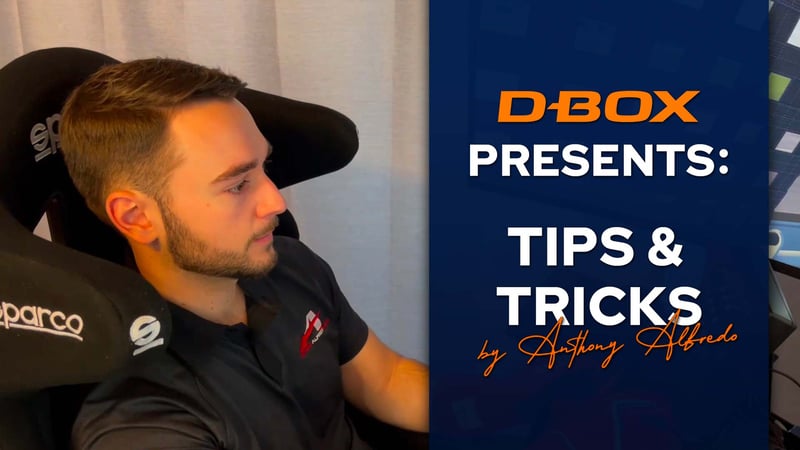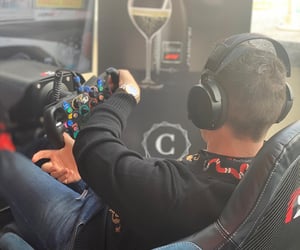How to apex a corner
One of the main skills that a driver needs to have is knowing how to apex a corner with ease. As Alfredo explains in his first video, the apex of a turn is the innermost portion of a track; also known as the edge of the track that you get the closest to with your vehicle!
The goal of successfully navigating an apex is to cut the radius of the track and make it as small as possible, thus requiring less time to drive a lap while maintaining maximum speed through the corner. However, to successfully apex a corner, you have locate the apex in advance—on some corners it will be early, on some corners it will be late, and on others it will be right in the center—it all depends on what the track evolves into after the corner.
By finding the proper apex, drivers are able to maintain as much speed as possible during the turn—leading to improved lap times and more races won.
How to bump and run
One of the most notorious moves in NASCAR racing, a bump and run occurs when you physically move the car in front of you to give you an advantage.
This manoeuvre is usually performed towards the end of a race when drivers are neck and neck for the win, fighting a tight battle to gain ground. If done properly, the move is clean, respectful, and allowed—but if done improperly, it can lead to a wreck for both you and your competitor.
As Alfredo explains, precision is key when it comes time to bump and run. If you do it on exit you run the risk of simply turning your opponent sideways instead of moving them out of the way, and if you do it on entry the car can become too unstable, causing the car ahead of you to crash.
By choosing the right time to bump and run in a race, you’ll make up valuable milliseconds in the race to the finish line—often with you coming out ahead.
How to run the high line
At racetracks where the track is fairly worn down, it’s a common strategy for drivers to run the high line all around the track. Running the high line means that drivers intentionally drive as close as possible to the track’s wall, avoiding the worn-out places and elongating the track overall—allowing them to accelerate over larger stretches of track and pick up more speed.
Successfully running the high line involves mastering the physics of the manoeuvre, creating a sort of air “bubble” of grip between your car and the wall!
For Alfredo, entering as high as possible is the most important thing to keep in mind. If you enter the high line too far away from the wall, then you’ll likely roll through the “bubble” of air and crash!
Keeping the bubble intact leads to more grip and more speed, but there’s a very fine line between maintaining the bubble and losing it. The more you practice on a haptic sim racing rig, the more you’ll get to know what exactly the “bubble” feels like, making you more likely to perfectly execute the move in a race!
How to set up a pass
For Alfredo, one of the easiest ways for him to decide whether or not he’s capable of passing a driver in front of him is by getting a feel for his car’s grip.
This is because to set up a pass, you need to have a lot of momentum—which builds easily when your car has a good grip on the track. Grip allows you to drive up underneath your opponent, and then to gain an advantage over them with your speed! However, getting the momentum needed to successfully complete a pass can be difficult, which is why haptic feedback will help you know the perfect moment that your car is ready to complete the trick.
How to threshold brake
The last Tips & Tricks video that Alfredo shared with D-BOX PLUS subscribers is about threshold braking—which is all about getting as much brake pressure as physically possible without locking up the front tires.
Usually used when approaching a hairpin corner, Alfredo says that the key to threshold braking is to get the maximum amount of pressure the second you switch from the accelerator to the brake. This moment is crucial because you’re at your fastest speed and have the most downforce in the front of the car in that moment, which allows you to use a lot of brake pressure without locking up the brakes.
If you miss this very short window of opportunity, you’ll have a very difficult time slowing down and making your corner in optimal fashion!
Learn more from the pro
If you would like to learn more sim racing Tips & Tricks from Alfredo, be sure to join D-BOX PLUS, our community platform of D-BOX fans who get first access to new content from our ambassadors and who are the first to hear about product launches!
Also, be sure to check out our blog interviews with Alfredo, in which he discusses his path from young child to NASCAR driver and in which he gives more advice to aspiring sim racers everywhere!


